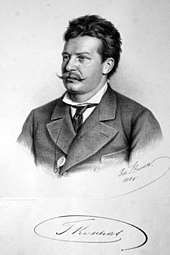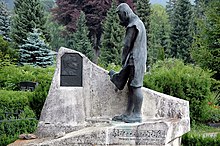Thomas Koschat

Thomas Koschat (born August 8, 1845 in Viktring near Klagenfurt , † May 19, 1914 in Vienna ) was an Austrian composer and choir director . He made the Carinthian song popular and known in Europe and America.
Childhood and youth
Thomas Koschat's father had married Ursula Tokar, 30 years his junior, when he was 61. The son from this marriage was named after his father Thomas, called Thomale. The father was employed as a master dyer in the cloth and loden factory of the Moro family, which was set up in the former Cistercian monastery Viktring, which was abolished under Joseph II . The mother worked in the same factory as a wool picker. The son should originally have become a textile chemist. The boy was introduced to music at an early age, as the Moro family liked to gather with friends in the castle courtyard to sing together. Fräulein Josefine, the sister of the factory owner Moro, directed the Viktringer church choir - she noticed Thomales singing early on. The child was allowed to participate in the church choir early, he served as minister for the pastor and was finally sent to Klagenfurt to the Benedictine high school. The father literally saved himself from attending high school.
Life
After graduating from high school in 1865, Koschat studied chemistry in Vienna. Leopold von Moro, the factory owner, had advised to study chemistry and also paid for the study costs, since his father died in 1862 when Thomale was still attending grammar school. He joined three choral societies in Vienna - the Wiedner Men's Choir, the Vienna Men's Choir and the Academic Choral Society. The latter was the stepping stone for him into the Vienna Court Opera as a bass player. On November 7th, 1867 he was engaged as a "choir bassist with a small role obligation". He later became director of the choir at the Vienna Court Opera. He founded the Koschat Quintet, with which he toured Europe and America. In addition to waltzes and choral songs, the quintet also played Carinthian songs, which became known beyond the country's borders. In the course of his life he received many awards for his services, particularly the Order of the Red Eagle , which was awarded to him by the German Emperor Wilhelm II .
In 1904 Koschat married Paula Massek, 30 years his junior. The marriage remained childless.
In 1907 he was made an honorary member of the Vienna Court Opera . When he retired in 1912, the Singspiel Am Wörthersee, which he had composed, was performed in honor of the Court Opera, in which he was director of the choir for decades.
Thomas Koschat is buried in an honorary grave of the city of Klagenfurt in the Annabichl cemetery. 622 choir members sang in the cemetery and many thousands accompanied him on his last journey.
In 1860 he was a founding member of the Carinthia Klagenfurt secondary school association , and as a student in 1865 he became a member of the Alemannia fraternity in Vienna .
On the occasion of the 10th anniversary of his death , a memorial plaque was unveiled at Koschat's death house, Strobachgasse 2, Vienna- Margareten .
In Klagenfurt there is a Thomas Koschat Museum , Koschatpark and Koschatstrasse in his memory . Thomas Koschat was an honorary citizen of the market town of Velden where today the Koschatpromenade remembers him. In 1919 the Koschatgasse in Vienna- Döbling (19th district) was named after him.
The Austrian Post issued a special stamp for its 125th birthday.
plant
Audio samples of Thomas Koschat's music can be found on the website of the Klagenfurt-Emmersdorf Singers' Group , who are dedicated to maintaining the songs of Thomas Koschat and who carry their music out into the world as the ambassador of the state of Carinthia. On the website of the singing group Klagenfurt-Emmersdorf it is written about Thomas Koschat:
“Based on the old Carinthian song, Thomas Koschat created a tremendous work that became known far beyond the borders of his home country and brought the composer great fame. He reworked many musical motifs from Carinthia into partly long choral works and thus created an independent music that can be recognized as typical for Koschat after just a few bars. With its Valâssn, valâssn ... and the snow waltz, Koschat is still a household name today. "
literature
- Peter Napetschnig: The Carinthian song prince Thomas Koschat - His life and work . Publisher MSc Media & Management GmbH, Bleiburg 2014.
- Alexander Rausch : Koschat, Thomas. In: Oesterreichisches Musiklexikon . Online edition, Vienna 2002 ff., ISBN 3-7001-3077-5 ; Print edition: Volume 3, Verlag der Österreichischen Akademie der Wissenschaften, Vienna 2004, ISBN 3-7001-3045-7 .
- Ambros Wilhelmer : Koschat, Thomas. In: Austrian Biographical Lexicon 1815–1950 (ÖBL). Volume 4, Verlag der Österreichischen Akademie der Wissenschaften, Vienna 1969, p. 141 f. (Direct links on p. 141 , p. 142 ).
- Koschat, Thomas . In: Meyers Großes Konversations-Lexikon . 6th edition. Volume 11, Bibliographisches Institut, Leipzig / Vienna 1907, p. 523 .
- Helge Dvorak: Biographical Lexicon of the German Burschenschaft. Volume II: Artists. Winter, Heidelberg 2018, ISBN 978-3-8253-6813-5 , pp. 417-418.
Web links
- Literature by and about Thomas Koschat in the catalog of the German National Library
- Entry on Thomas Koschat in the Austria Forum (in the AEIOU Austria Lexicon )
- Song board of the singers group Klagenfurt-Emmersdorf with audio samples to the music of Thomas Koschat
- Mixed choir Koschat Hamat Viktring, founded by Thomas Koschat in 1890
- Sheet music and audio files by Thomas Koschat in the International Music Score Library Project
- Thomas Koschat in the Vienna History Wiki of the City of Vienna
Individual evidence
- ↑ Valåssn, but not forgotten , Kleine Zeitung Online (accessed May 9, 2016)
- ^ Helge Dvorak: Biographical Lexicon of the German Burschenschaft. Volume II: Artists. Winter, Heidelberg 2018, ISBN 978-3-8253-6813-5 , p. 417.
- ↑ The unveiling of a Koschat memorial plaque. In: Wiener Bilder , No. 20/1924 (XXIXth year), May 18, 1924, p. 5 below. (Online at ANNO ). .
- ↑ The Koschat Museum on the website of the Koschatbund Men's Choir, Klagenfurt
- ↑ Ambros Wilhelmer : Thomas Koschat special postage stamp, 125th birthday . Vienna: Austrian State Printing Office 1970
Web links
| personal data | |
|---|---|
| SURNAME | Koschat, Thomas |
| BRIEF DESCRIPTION | Austrian composer and choir director |
| DATE OF BIRTH | August 8, 1845 |
| PLACE OF BIRTH | Viktring near Klagenfurt , Austria |
| DATE OF DEATH | May 19, 1914 |
| Place of death | Vienna |




